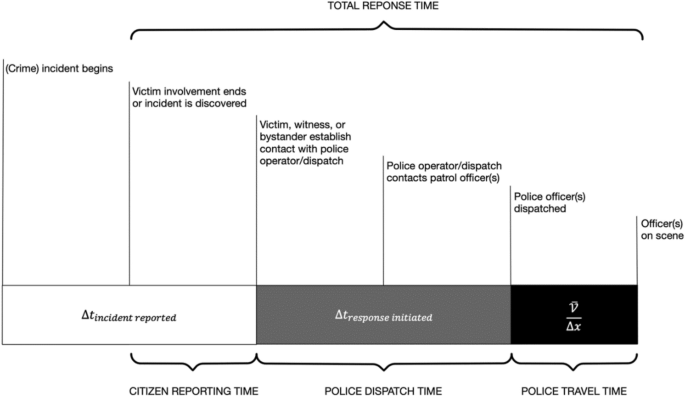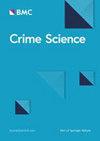Predictors of police response time: a scoping review
IF 3.1
Q1 CRIMINOLOGY & PENOLOGY
引用次数: 0
Abstract
Abstract Background As rapid response has been a key policing strategy for police departments around the globe, so has police response time been a key performance indicator. This scoping review maps and assesses the variables that predict police response time. Methods This review considers empirical studies, written in english, that include quantitative data from which an association between the outcome variable police response time and any predictor can be observed or derived. This review provides both a narrative synthesis as well as what we termed a hybrid synthesis , a novel way of synthesizing a large quantitative dataset which is considered too rich for a mere narrative synthesis and yet does not allow for meta-analysis. Results The search, screening and selection process yielded 39 studies, which presented 630 associations between 122 unique predictor variables and police response time. In order to present the results in a digestible way, we classified these into categories and subcategories. All methodological steps and the findings are made public: https://github.com/timverlaan/prt . Conclusions Most of the conclusion and discussion focuses on lessons learned and recommendations for future research, as it proved hard to draw any definitive conclusions on causal factors related to police response time. We recommend that future studies clearly describe mechanisms, focus on the components of police response time (reporting time, dispatch time, travel time—or a combination of these), attempt to standardize predictors and outcome variables, and we call for more research into reporting time . We conclude this review with a first attempt at deriving a causal model of police response time from the subcategories of predictor variables we observed in the empirical studies included in this review. Trail Registration : https://osf.io/hu2e9 .

警察反应时间的预测因素:范围审查
摘要背景快速反应已成为全球警察部门的一项关键警务策略,因此警察反应时间已成为一项关键绩效指标。这个范围审查地图和评估预测警察反应时间的变量。方法本综述考虑了以英语撰写的实证研究,包括定量数据,从中可以观察或推导出结果变量警察反应时间与任何预测因子之间的关联。这篇综述既提供了叙述性综合,也提供了我们所谓的混合综合,这是一种综合大型定量数据集的新方法,这种数据集被认为过于丰富,无法进行单纯的叙述性综合,也不允许进行元分析。结果搜索、筛选和选择过程产生了39项研究,其中122个独特的预测变量与警察反应时间之间存在630种关联。为了以易于理解的方式呈现结果,我们将这些分类为类别和子类别。所有的方法步骤和结果都是公开的:https://github.com/timverlaan/prt。结论和讨论的大部分重点是吸取的教训和对未来研究的建议,因为事实证明很难就与警察反应时间有关的因果因素得出任何明确的结论。我们建议未来的研究清楚地描述机制,关注警察反应时间的组成部分(报告时间、调度时间、旅行时间或这些的组合),尝试标准化预测因素和结果变量,我们呼吁对报告时间进行更多的研究。我们在总结这篇综述时,首先尝试从我们在这篇综述的实证研究中观察到的预测变量的子类别中推导出警察反应时间的因果模型。活动报名:https://osf.io/hu2e9。
本文章由计算机程序翻译,如有差异,请以英文原文为准。
求助全文
约1分钟内获得全文
求助全文
来源期刊

Crime Science
Social Sciences-Cultural Studies
CiteScore
11.90
自引率
8.20%
发文量
12
审稿时长
13 weeks
期刊介绍:
Crime Science is an international, interdisciplinary, peer-reviewed journal with an applied focus. The journal''s main focus is on research articles and systematic reviews that reflect the growing cooperation among a variety of fields, including environmental criminology, economics, engineering, geography, public health, psychology, statistics and urban planning, on improving the detection, prevention and understanding of crime and disorder. Crime Science will publish theoretical articles that are relevant to the field, for example, approaches that integrate theories from different disciplines. The goal of the journal is to broaden the scientific base for the understanding, analysis and control of crime and disorder. It is aimed at researchers, practitioners and policy-makers with an interest in crime reduction. It will also publish short contributions on timely topics including crime patterns, technological advances for detection and prevention, and analytical techniques, and on the crime reduction applications of research from a wide range of fields. Crime Science publishes research articles, systematic reviews, short contributions and theoretical articles. While Crime Science uses the APA reference style, the journal welcomes submissions using alternative reference styles on a case-by-case basis.
 求助内容:
求助内容: 应助结果提醒方式:
应助结果提醒方式:


